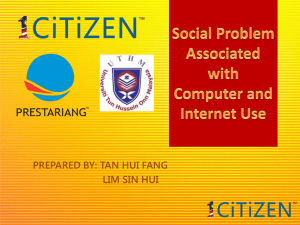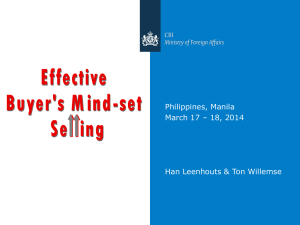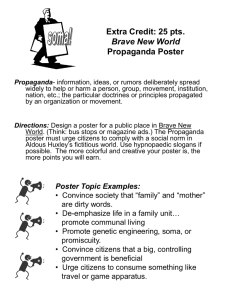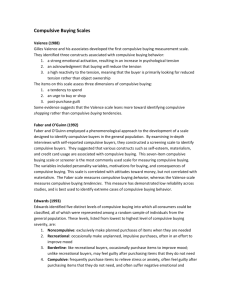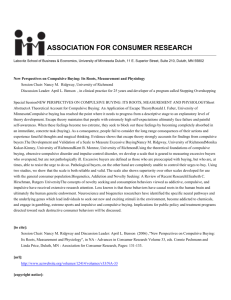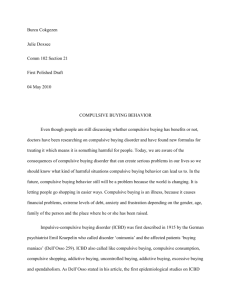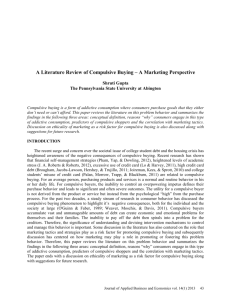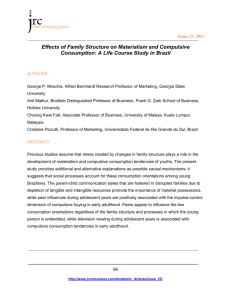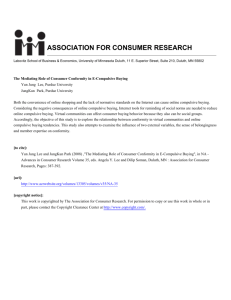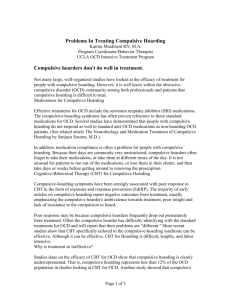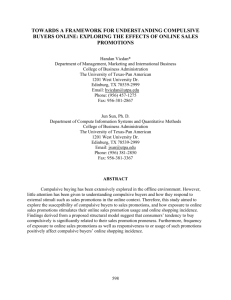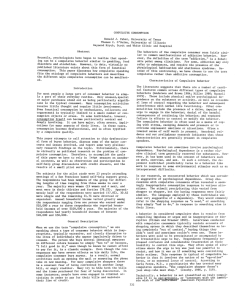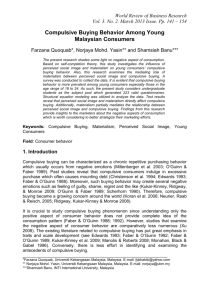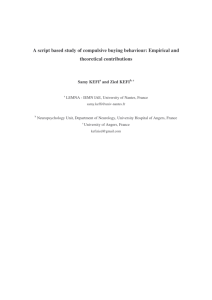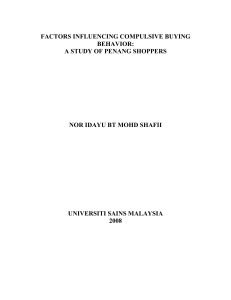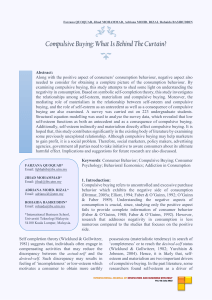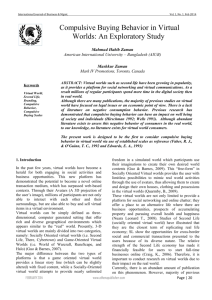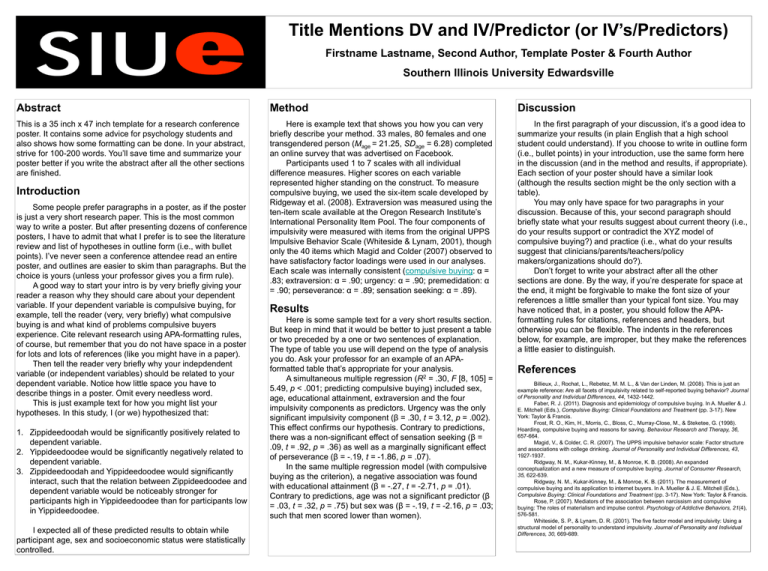
Title Mentions DV and IV/Predictor (or IV’s/Predictors)
Firstname Lastname, Second Author, Template Poster & Fourth Author
Southern Illinois University Edwardsville
Abstract
Method
Discussion
This is a 35 inch x 47 inch template for a research conference
poster. It contains some advice for psychology students and
also shows how some formatting can be done. In your abstract,
strive for 100-200 words. You’ll save time and summarize your
poster better if you write the abstract after all the other sections
are finished.
Here is example text that shows you how you can very
briefly describe your method. 33 males, 80 females and one
transgendered person (Mage = 21.25, SDage = 6.28) completed
an online survey that was advertised on Facebook.
Participants used 1 to 7 scales with all individual
difference measures. Higher scores on each variable
represented higher standing on the construct. To measure
compulsive buying, we used the six-item scale developed by
Ridgeway et al. (2008). Extraversion was measured using the
ten-item scale available at the Oregon Research Institute’s
International Personality Item Pool. The four components of
impulsivity were measured with items from the original UPPS
Impulsive Behavior Scale (Whiteside & Lynam, 2001), though
only the 40 items which Magid and Colder (2007) observed to
have satisfactory factor loadings were used in our analyses.
Each scale was internally consistent (compulsive buying: α =
.83; extraversion: α = .90; urgency: α = .90; premedidation: α
= .90; perseverance: α = .89; sensation seeking: α = .89).
In the first paragraph of your discussion, it’s a good idea to
summarize your results (in plain English that a high school
student could understand). If you choose to write in outline form
(i.e., bullet points) in your introduction, use the same form here
in the discussion (and in the method and results, if appropriate).
Each section of your poster should have a similar look
(although the results section might be the only section with a
table).
You may only have space for two paragraphs in your
discussion. Because of this, your second paragraph should
briefly state what your results suggest about current theory (i.e.,
do your results support or contradict the XYZ model of
compulsive buying?) and practice (i.e., what do your results
suggest that clinicians/parents/teachers/policy
makers/organizations should do?).
Don’t forget to write your abstract after all the other
sections are done. By the way, if you’re desperate for space at
the end, it might be forgivable to make the font size of your
references a little smaller than your typical font size. You may
have noticed that, in a poster, you should follow the APAformatting rules for citations, references and headers, but
otherwise you can be flexible. The indents in the references
below, for example, are improper, but they make the references
a little easier to distinguish.
Introduction
Some people prefer paragraphs in a poster, as if the poster
is just a very short research paper. This is the most common
way to write a poster. But after presenting dozens of conference
posters, I have to admit that what I prefer is to see the literature
review and list of hypotheses in outline form (i.e., with bullet
points). I’ve never seen a conference attendee read an entire
poster, and outlines are easier to skim than paragraphs. But the
choice is yours (unless your professor gives you a firm rule).
A good way to start your intro is by very briefly giving your
reader a reason why they should care about your dependent
variable. If your dependent variable is compulsive buying, for
example, tell the reader (very, very briefly) what compulsive
buying is and what kind of problems compulsive buyers
experience. Cite relevant research using APA-formatting rules,
of course, but remember that you do not have space in a poster
for lots and lots of references (like you might have in a paper).
Then tell the reader very briefly why your indepdendent
variable (or independent variables) should be related to your
dependent variable. Notice how little space you have to
describe things in a poster. Omit every needless word.
This is just example text for how you might list your
hypotheses. In this study, I (or we) hypothesized that:
1. Zippideedoodah would be significantly positively related to
dependent variable.
2. Yippideedoodee would be significantly negatively related to
dependent variable.
3. Zippideedoodah and Yippideedoodee would significantly
interact, such that the relation between Zippideedoodee and
dependent variable would be noticeably stronger for
participants high in Yippideedoodee than for participants low
in Yippideedoodee.
I expected all of these predicted results to obtain while
participant age, sex and socioeconomic status were statistically
controlled.
Results
Here is some sample text for a very short results section.
But keep in mind that it would be better to just present a table
or two preceded by a one or two sentences of explanation.
The type of table you use will depend on the type of analysis
you do. Ask your professor for an example of an APAformatted table that’s appropriate for your analysis.
A simultaneous multiple regression (R2 = .30, F [8, 105] =
5.49, p < .001; predicting compulsive buying) included sex,
age, educational attainment, extraversion and the four
impulsivity components as predictors. Urgency was the only
significant impulsivity component (β = .30, t = 3.12, p = .002).
This effect confirms our hypothesis. Contrary to predictions,
there was a non-significant effect of sensation seeking (β =
.09, t = .92, p = .36) as well as a marginally significant effect
of perseverance (β = -.19, t = -1.86, p = .07).
In the same multiple regression model (with compulsive
buying as the criterion), a negative association was found
with educational attainment (β = -.27, t = -2.71, p = .01).
Contrary to predictions, age was not a significant predictor (β
= .03, t = .32, p = .75) but sex was (β = -.19, t = -2.16, p = .03;
such that men scored lower than women).
References
Billieux, J., Rochat, L., Rebetez, M. M. L., & Van der Linden, M. (2008). This is just an
example reference: Are all facets of impulsivity related to self-reported buying behavior? Journal
of Personality and Individual Differences, 44, 1432-1442.
Faber, R. J. (2011). Diagnosis and epidemiology of compulsive buying. In A. Mueller & J.
E. Mitchell (Eds.), Compulsive Buying: Clinical Foundations and Treatment (pp. 3-17). New
York: Taylor & Francis.
Frost, R. O., Kim, H., Morris, C., Bloss, C., Murray-Close, M., & Steketee, G. (1998).
Hoarding, compulsive buying and reasons for saving. Behaviour Research and Therapy, 36,
657-664.
Magid, V., & Colder, C. R. (2007). The UPPS impulsive behavior scale: Factor structure
and associations with college drinking. Journal of Personality and Individual Differences, 43,
1927-1937.
Ridgway, N. M., Kukar-Kinney, M., & Monroe, K. B. (2008). An expanded
conceptualization and a new measure of compulsive buying. Journal of Consumer Research,
35, 622-639.
Ridgway, N. M., Kukar-Kinney, M., & Monroe, K. B. (2011). The measurement of
compulsive buying and its application to internet buyers. In A. Mueller & J. E. Mitchell (Eds.),
Compulsive Buying: Clinical Foundations and Treatment (pp. 3-17). New York: Taylor & Francis.
Rose, P. (2007). Mediators of the association between narcissism and compulsive
buying: The roles of materialism and impulse control. Psychology of Addictive Behaviors, 21(4),
576-581.
Whiteside, S. P., & Lynam, D. R. (2001). The five factor model and impulsivity: Using a
structural model of personality to understand impulsivity. Journal of Personality and Individual
Differences, 30, 669-689.

